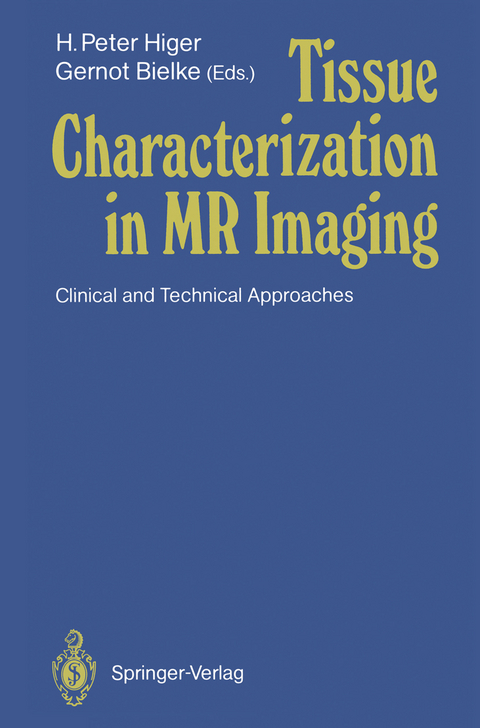
Tissue Characterization in MR Imaging
Springer Berlin (Verlag)
978-3-642-74995-7 (ISBN)
H.P. HIGER 1 In the seventeenth century people dreamed about a machine to get rid of evil spirits and obsessions, which were thought to be the main source of mis fortune and disease. I am not going to question this approach, because in a way it sounds reasonable. They dreamed of a machine that would display im ages from the inner world of men which could be easily identified and named. Somehow these are the roots of MR imaging. Of course, we now view disease from a different point of view but our objectives remain the same, namely to make diseases visible and to try to characterize them in order to cure them. This was the reason for setting up a symposium on tissue characterization. About 300 years later the clinical introduction of MRI has great potential for making this dream come true, and I hope that this symposium has con stituted another step toward its realization. When Damadian published his article in 1971 about differences in T1 relaxation times between healthy and pathological tissues, this was a milestone in tissue characterization. His results initiated intensive research in to MR imaging and tissue parameters. Actually his encouraging discovery was not only the first but also the last for a long time in the field of MR tissue characterization.
I. Methods and Techniques Relaxation Parameters.- Relaxation Parameters.- General Need for Quantitative Methodologies in Tissue Characterization by MRI.- NMR Parameter Calculations.- The Application of Surface Coils for Tissue Characterization - Demonstrated by the Determination of T2 Relaxation Times.- Determination of T1 by Three-dimensional Measurement with Triangle Excitation.- Improving the Accuracy of T1 Measurements In Vivo: The Use of the Hyperbolic Secant Pulse in the Saturation Recovery/Inversion Recovery Sequence.- Volume-Selective Tissue Characterization by T1? Dispersion Measurements and T1? Dispersion Imaging.- Two New Pulse Sequences for Efficient Determination of Tissue Parameters in MRI.- Characterization of Brain Tissues by the Field Dependence of Their Longitudinal Relaxation Rates.- A Biochemical Approach to the Interpretation of MRI Images: In Vitro Study on a Craniopharyngioma.- Comparison of Algorithms for the Decomposition of Multiexponential Relaxation Processes Using SUNRISE.- Preprocessing of Magnetization Decays to Improve Multiexponential T2 Analysis.- Advantages of Multiexponential T2 Analysis.- MRI Relaxation of Brain Tissue: A Statistical Estimate of Deviations from Ideality.- Lower Error Bounds for the Estimation of Relaxation Parameters.- Signal Mechanisms and Influences.- Multiexponential Relaxation Analysis of Precontrast MRI in Comparison with Gadolinium-DTPA MRI.- A Chemical Shift Imaging Strategy for Paramagnetic Contrast-Enhanced MRI.- Experimental Approach to Rho-Related Contrast in Clinical MRI.- Serial Inversion Nulling Syntheses ("SINS") to Enhance Lesion Contrast.- Pattern Recognition.- Tissue Characterization with MRI: The Value of the MR Parameters.- Using an "Information Manager" as a Component of a TissueClassification System in NMR Tomography.- MR Tissue Characterization Using Iconic Fuzzy Sets.- Tissue Discrimination in Three-dimensional Imaging by Texture Analysis.- Generation of Tissue-Specific Images by Means of Multivariate Data Analysis of MR Images.- Feature Extraction from NMR Images Using Factor Analysis.- Multispectral Analysis of Magnetic Resonance Images:A Comparison Between Supervised and Unsupervised Classification Techniques.- Textural Analysis of Quantitative Magnetic Resonance Imaging in Metabolic Bone Disease - An Approach to Tissue Characterisation of the Spine.- Tissue Type Imaging - An Approach to Clinical Use.- II. Clinical Results Musculoskeletal.- Musculoskeletal.- MRI Evaluation of Early Degenerative Cartilage Disease by a Three-dimensional Gradient Echo Sequence.- MRI vs Scintigraphy in the Detection of Vertebral Metastases:Preliminary Results.- MRI of Osteomyelitis.- MRI in Bone Infection.- MR Imaging After Trauma and Orthopedic Surgery.- MRI Tissue Characterization of an Anatomical Structure Subject to Major Functional Displacement: The Temporomandibular Joint.- Body.- Tissue Characterization of Focal Lesions by Liver MR Imaging.- Differentiation of Focal Liver Lesions by Contrast-Enhanced MRI.- Investigation of Liver Pathology with Magnetite-Dextran Superparamagnetic Nanoparticles as New MRI Contrast Agent.- Contrast-Enhanced MR Imaging of Urinary Bladder Neoplasms.- Stage I Endometrial Carcinoma: High Field (1.5T) MR Imaging Features.- Mamma.- Breast-Tissue Differentiation by MRI: Results of 361 Examinations in 5 Years.- T1 Measurements by TOMROP: First Experiences and Applications in In Vivo Breast Studies.- Miscellaneous.- Correlations Between NMR Relaxation Times and Histopathological Features in Abnormal Thyroid and ParathyroidGlands:Preliminary Results.- Proton NMR Relaxation Times and Trace Paramagnetic Metal Contents: Pattern Recognition Analysis of the Discrimination Between Normal and Pathological Tissue of the Gastrointestinal Tract and Bone Marrow.- Head and Brain.- Tissue Characterization in Brain Lesions: A Review of the State of the Art.- Quantitative Analysis of Multiple Sclerosis by Means of MRI.- Differentiation of Gliomas Using Tissue Parameters and a Three-dimensional Density Distribution Model.- Tissue Accessibility of Gd-DTPA in Meningiomas and Neuromas.- Eye Muscle Changes in Graves' Ophthalmopathy:Differentiation by MRI.- Assessment of Clinical Activity in Endocrine Orbitopathy with T2 Values - Response to Immunomodulating Therapy.- MRI Tissue Characterization and Segmentation of Human Brain Tissues Using a Prolog-Based Expert System.- Calculated T1 and T2 in Nonresectable Brain Tumors to Monitor the Effects of Cranial Radiation.- Dexamethasone Effect on MR Parameters in Brain Tumors.- III. Round-Table Discussion.- Concluding Remarks.
| Erscheint lt. Verlag | 13.12.2011 |
|---|---|
| Zusatzinfo | XVII, 340 p. |
| Verlagsort | Berlin |
| Sprache | englisch |
| Maße | 155 x 235 mm |
| Gewicht | 551 g |
| Themenwelt | Medizinische Fachgebiete ► Radiologie / Bildgebende Verfahren ► Kernspintomographie (MRT) |
| Medizinische Fachgebiete ► Radiologie / Bildgebende Verfahren ► Radiologie | |
| Medizin / Pharmazie ► Physiotherapie / Ergotherapie ► Orthopädie | |
| Studium ► 1. Studienabschnitt (Vorklinik) ► Anatomie / Neuroanatomie | |
| Schlagworte | Bone • brain • Cartilage • classification • Contrast agent • Gewebecharakterisierung • Magnetic Resonance • Magnetic Resonance Imaging (MRI) • Monitor • MRI • MR imaging • NMR • Pathology • Scintigraphy • Surgery • tissue • Tomography |
| ISBN-10 | 3-642-74995-X / 364274995X |
| ISBN-13 | 978-3-642-74995-7 / 9783642749957 |
| Zustand | Neuware |
| Haben Sie eine Frage zum Produkt? |
aus dem Bereich


